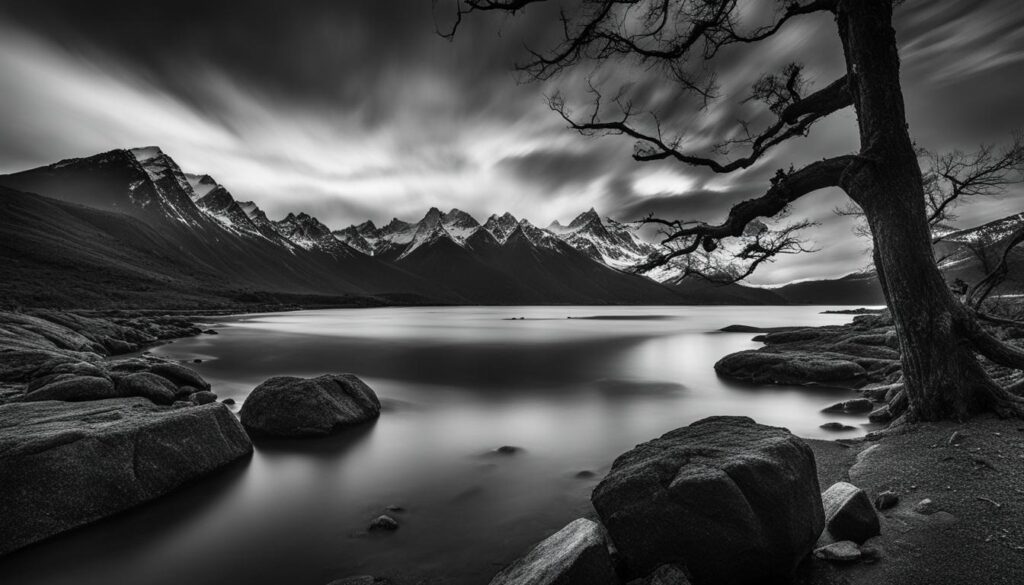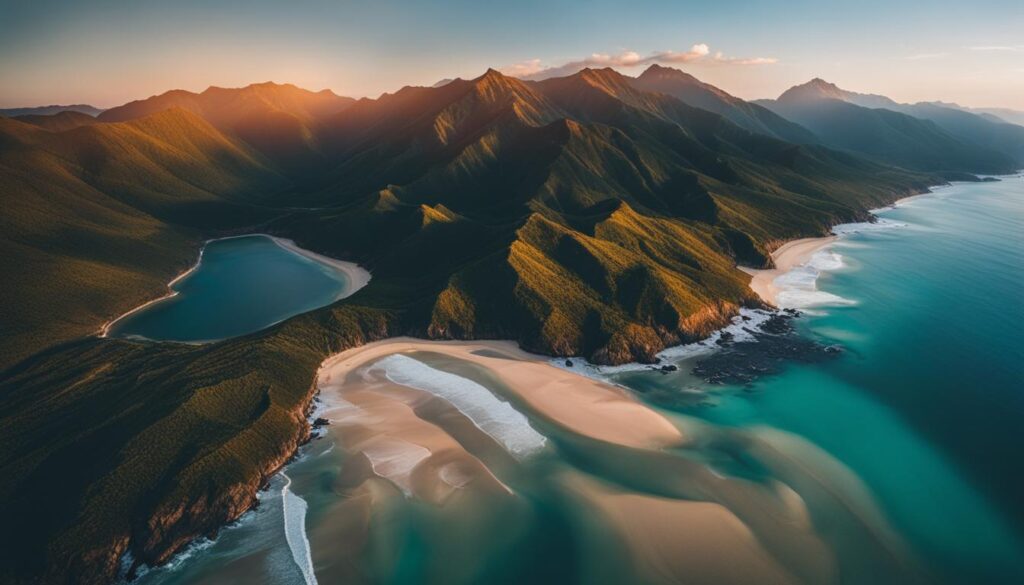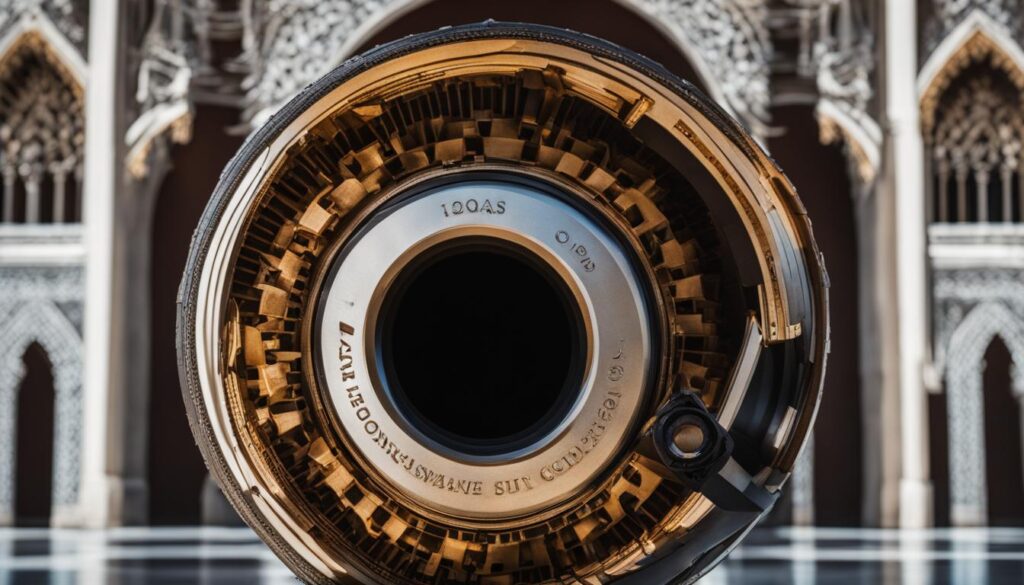We may earn money or products from the companies mentioned in this post.
Black and white photography has a timeless charm that never goes out of style. It captures the essence of a moment and evokes emotions like no other art form. Whether you’re a budding photographer or a seasoned pro, mastering the art of black and white photography can enhance your skills and take your images to new heights of visual appeal. In this section, we will explore the art of black and white photography and learn valuable tips and techniques to elevate your skills. We will also delve into the timeless charm of monochrome images and discover the beauty of vintage photography.
Key Takeaways
- Black and white photography has a timeless charm that captures the essence of a moment.
- Mastering the art of black and white photography can enhance your skills and take your images to new heights.
- Monochrome images have a timeless charm that never goes out of style.
- Vintage photography has a unique appeal that captures the glory of the past.
- Black and white photography allows you to create impactful images that evoke emotions and tell compelling stories.
Understanding the Essence of Black and White Photography
Black and white photography is a timeless art form that has been used by photographers for centuries to create impactful and evocative images. Grayscale photos, with their unique tonality, contrast, and ability to highlight the beauty of light and shadow, offer a different perspective than color images. From the early days of photographic technology to the modern-day digital era, black and white photography has remained a popular choice for many fine art photographers.
The Power of Contrast Photography
Contrast is a crucial element of black and white photography. High contrast images with deep blacks and bright whites can create a striking visual impact. Balancing contrast can help to bring out the details in a photo, adding depth and texture to your images. By adjusting the contrast levels, you can create different moods that range from dramatic and bold to soft and ethereal.
Fine Art Photography and Black and White Images
Black and white photography is often associated with fine art due to its ability to evoke emotions and tell a story through visuals. Fine art photography encompasses a broad range of styles, from landscape photography to portraiture. Through the use of black and white images, photographers can create timeless photographs that are both visually striking and emotionally engaging. The unique monochromatic tones allow the viewer to focus on the essence of the image and the emotions it conveys.
“Black and white are the colors of photography. To me, they symbolize the alternatives of hope and despair to which mankind is forever subjected.” – Robert Frank
Mastering Composition in Black and White Photography
Black and white photography has always been associated with classic and timeless photography. As a photographer, understanding composition is crucial to creating visually appealing and memorable images. In this section, we will explore some classic composition techniques that can elevate your black and white photography skills to new heights.
The Rule of Thirds
The rule of thirds is a classic composition technique used in both color and black and white photography. The idea is to divide your image into thirds vertically and horizontally, creating a grid of nine equal parts.
Placing your subject off-center at one of the four intersecting points can add visual interest and balance to your image. This technique can also help to create a sense of movement or lead the eyes of the viewer towards a specific point in the image.
| Without Rule of Thirds | With Rule of Thirds |
|---|---|
 |
 |
Simplicity
Simplicity is another important aspect of classic photography. When composing your shot, try to keep the focus on your subject and eliminate any unnecessary elements that may distract from your subject.
This technique can help to create a clean and uncluttered image that is visually pleasing to the eye. A simple and well-composed black and white photograph can be a powerful tool to convey emotions and tell a story.
Lines and Patterns
Lines and patterns can add depth and texture to your black and white images. Look for lines in your surroundings, such as roads or fences, and use them to guide the viewer’s eye through your image.
Patterns, such as those found in architecture or nature, can also add visual interest and complexity to your images. Experiment with different angles and perspectives to capture unique patterns and create visually engaging photographs.
| Lines | Patterns |
|---|---|
 |
 |
Contrast
Contrast is an important element in black and white photography and can help to create a dramatic and impactful image. Look for subjects with high contrast, such as a white flower against a dark background, to create a striking image.
You can also create contrast by adjusting the exposure or using post-processing techniques to enhance the shadows and highlights in your image. However, be careful not to overdo it and lose the natural tones and textures in your photograph.
Lighting Techniques for Black and White Photography
Lighting is an essential element in black and white photography, and understanding how to use it effectively is key to creating stunning images. Whether you’re shooting in a studio or natural light setting, proper lighting techniques can add depth and dimension to your photos.
The Importance of Contrast
One of the most critical lighting techniques in black and white photography is creating contrast. Contrast involves creating a difference in brightness between the lightest and darkest parts of an image, which can add dimension and depth. When it comes to black and white photography, contrast is particularly essential because it helps create separation between the various shades of gray.
There are several ways to achieve contrast in your images. One technique involves using a single light source, such as a window or lamp, to create shadows and highlights. Another method involves using multiple light sources to illuminate different areas of the subject.
Embracing Shadows
Shadows are a natural part of black and white photography, and they can add a sense of drama and mystery to your images. By embracing shadows and including them in your compositions, you can create a more dynamic and visually engaging photo.
To incorporate shadows into your photos, experiment with different angles and lighting setups. Try placing your subject in front of a backlit window or using a single light source to create strong shadows. Remember to pay attention to the direction of the light and adjust it as needed to create the desired effect.
Creating a Vintage Look
Vintage photography often relies on specific lighting styles to create a nostalgic feel. By using techniques like low-key lighting, you can create images that appear as if they were taken in another era.
To achieve a vintage look in your photos, experiment with different lighting setups and filters. Try using warm, yellow-toned lights or incorporating soft focus to create a dreamy, atmospheric effect.
Post-processing Tips for Stunning Black and White Photos
Post-processing is a crucial step in creating captivating black and white images. Whether you’re converting color images to monochrome or enhancing the contrast in your grayscale photos, the right tools and techniques can help you achieve stunning results. In this section, we’ll explore some post-processing tips that can take your black and white photography to the next level.
1. Choose the Right Software
When it comes to post-processing black and white photos, there are plenty of software options available. However, not all software is created equal, and some programs are better suited for certain tasks than others. For example, Adobe Lightroom offers robust editing tools, while Silver Efex Pro is specifically designed for black and white photography. Do your research and choose a software that best fits your needs and workflow.
2. Experiment with Contrast and Tones
Contrast is a key element in black and white photography. By adjusting the contrast and tones in your photos, you can create images that are bold and dramatic or soft and dreamy. Play around with the brightness, highlights, shadows, and mid-tones in your images to find the perfect balance.
3. Consider Cropping and Composition
Cropping and composition can make or break a black and white photo. By cropping your images, you can change the focus and create a stronger sense of subjectivity. Additionally, take some time to experiment with different compositions, such as the rule of thirds or leading lines, to create dynamic and visually engaging images.
4. Don’t Be Afraid to Get Creative
Black and white photography is incredibly versatile, and there are plenty of ways to get creative with your post-processing. For example, you can experiment with selective color, adding a pop of color to an otherwise monochrome image. Alternatively, you can add texture or grain to create a vintage or film-like effect. The possibilities are endless, so don’t be afraid to try something new.
5. Convert Color Images to Monochrome
If you’re working with color images, consider converting them to monochrome. Converting to black and white allows you to focus on the composition and lighting of the image, rather than being distracted by the colors. You can use software tools to adjust the brightness and contrast of the various colors in the original photo to create depth and interest in the resulting black and white image.
By following these post-processing tips, you can take your black and white photography to the next level and create stunning, monochrome images that capture the essence of your subject matter.
Expressing Emotion through Documentary Black and White Photography
Documentary photography is a genre that aims to depict reality and tell stories through images. Black and white photography has been a preferred medium for documentary photographers as it can capture raw emotions and convey a sense of timelessness.
Documentary black and white photography is not just about taking pictures, but also about telling stories. Through these images, photographers can shed light on important social, environmental, or political issues and evoke empathy and understanding in the viewers.
The Power of Black and White Photography in Documenting Reality
The use of black and white photography in documentary work can elevate the impact of the images. Without the distraction of color, the focus is on the subject, expression, and emotion. The use of shadows, light, and contrast can enhance the mood and atmosphere of the image, creating a more powerful message.
A great example of this is Dorothea Lange’s iconic photograph “Migrant Mother.” Shot in 1936 during the Great Depression, the image captures the desperation and exhaustion of a mother of seven children. The drab conditions, the wrinkles on the mother’s face, and the expressions of the children, all contribute to create an image that is incredibly powerful and emotional.
“One of the reasons photography fascinates me is that it is the perfect medium for the imperfect, the fleeting, and the transitory. Photographs can distill the essence of a moment before it’s gone forever, and that is what I aim to do – not just to record events, but to capture the mood, the emotion, and the soul that lie beneath.”
– Steve McCurry, Documentary Photographer
Black and White Photography as a Tool for Social Change
Documentary black and white photography has been used since its inception as a tool for social and political change. Photographs can inspire people to action, open their eyes to injustices, and create a sense of urgency.
For example, during the Civil Rights movement in the United States, photographers like Gordon Parks documented the struggle for equality and justice through their images. The raw emotions and the harsh reality of the situation were captured in stunning black and white photographs, challenging the status quo and inspiring change.
Conclusion
Black and white photography is a captivating art form that has stood the test of time. By mastering composition, understanding lighting techniques, and utilizing post-processing tools, you can create stunning monochrome images that evoke deep emotions and stand out from the crowd.
Classic or Documentary Photography?
Whether you’re drawn to classic or documentary black and white photography, the power of monochrome images will continue to inspire and captivate audiences for years to come. Classic photography relies on timeless composition techniques and lighting to create stunning visuals, while documentary photography emphasizes raw emotions and storytelling.
Unleash Your Creativity
Black and white photography offers endless possibilities for creative expression. Whether you’re shooting landscapes, portraits, or street photography, there are always new techniques and ideas to explore. Don’t be afraid to experiment and take risks, as the most powerful images often come from pushing boundaries.
Take Your Skills to New Heights
With these tips and techniques, you can take your black and white photography skills to new heights. Whether you’re a seasoned pro or just starting, there are always new skills and ideas to learn. So get out there and start capturing the timeless beauty of black and white photography!
FAQ
What is black and white photography?
Black and white photography is a style of photography that captures images using only shades of gray, from pure black to pure white, without any colors. It is known for its timeless and classic appeal.
What are monochrome images?
Monochrome images are images that are composed of only shades of a single color or shades of gray. In black and white photography, the monochrome color used is grayscale, which ranges from pure black to pure white.
What is vintage photography?
Vintage photography refers to photographs that were taken in the past and have a nostalgic aesthetic. It often involves using specific techniques, such as sepia tones or aged effects, to create a vintage look and feel.
How can contrast be used in black and white photography?
Contrast is a key element in black and white photography. It refers to the difference between the darkest and lightest areas of an image. By manipulating contrast, photographers can create dramatic and impactful compositions.
What is fine art photography?
Fine art photography is a genre of photography that is created with artistic intent. It often focuses on expressing the photographer’s personal vision and emotions and is considered a form of artistic expression.
What are classic composition techniques in black and white photography?
Classic composition techniques in black and white photography include the rule of thirds, leading lines, symmetry, and framing. These techniques are used to create visually pleasing and balanced compositions.
How does lighting affect black and white photography?
Lighting plays a crucial role in black and white photography. It can add depth, shadows, and highlights to the image, enhancing its overall impact. Different lighting techniques can create various moods and atmospheres in black and white photographs.
What are some post-processing tips for black and white photos?
Some post-processing tips for black and white photos include adjusting the levels of black and white tones, enhancing contrast, and fine-tuning the overall tonal range. Software tools like Adobe Photoshop and Lightroom are commonly used for post-processing black and white images.
How do documentary photographers use black and white images to express emotions?
Documentary photographers often use black and white images to capture raw and authentic emotions. The absence of color allows the viewer to focus on the subject matter and the emotions conveyed, creating a powerful and impactful visual narrative.
Affiliate Disclosure: This post may contain affiliate links. If you purchase through our link, we may receive a small commission, but at no additional cost to you. For more information, please see our Disclosure statement.



